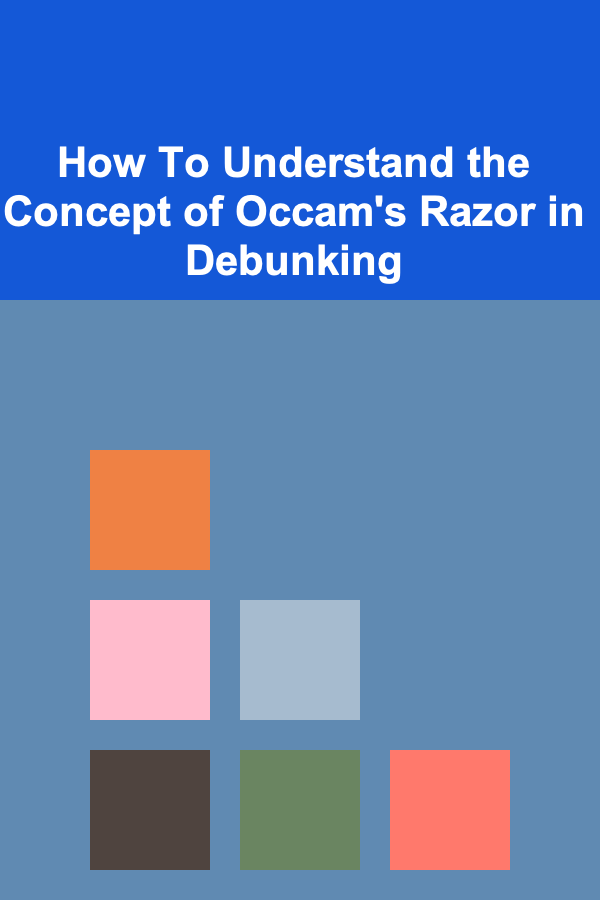
How To Understand the Concept of Occam's Razor in Debunking
ebook include PDF & Audio bundle (Micro Guide)
$12.99$8.99
Limited Time Offer! Order within the next:

Occam's Razor is one of the most commonly discussed principles in philosophy, science, and critical thinking. It is a heuristic or problem-solving tool that suggests that the simplest explanation, one that introduces the fewest assumptions, is often the most likely to be correct. Though Occam's Razor has its roots in philosophy, it has found its place in various domains of study, especially in debunking false claims, misconceptions, and pseudoscience. Understanding how this principle applies to debunking can be crucial for anyone who seeks to critically assess information in the modern world. In this article, we will explore the concept of Occam's Razor in depth, discuss its historical background, explain how it can be applied in debunking, and reflect on its limitations.
Historical Background of Occam's Razor
The principle of Occam's Razor is named after the English philosopher and theologian William of Ockham (1287--1347), who is often credited with formalizing the concept. However, the idea itself predates Ockham by centuries, and there are various philosophical and theological precedents for Occam's approach to simplification.
William of Ockham was a member of the Franciscan Order and is best known for his work in logic and philosophy. He argued that when faced with competing hypotheses or explanations, the one that makes the fewest assumptions should be preferred. The Latin phrase that best encapsulates this principle is "Entia non sunt multiplicanda sine necessitate," which translates to "Entities should not be multiplied without necessity." Essentially, this suggests that we should not postulate more entities or causes than are necessary to explain a phenomenon.
While Ockham's Razor is often understood as a tool for simplifying theories, its true power lies in its emphasis on parsimony. Parsimony, in this case, means that we should favor explanations that are straightforward and require fewer speculative assumptions. This concept has endured for centuries due to its robustness in various fields, from theology to modern scientific research.
The Core Concept of Occam's Razor
Occam's Razor can be described as a heuristic principle rather than a strict law. A heuristic is a mental shortcut that helps people make decisions or solve problems efficiently. In the case of Occam's Razor, it guides thinkers to prefer explanations that are simple, direct, and based on known facts. This is particularly useful in debunking because complex, convoluted explanations are often a sign of faulty reasoning or pseudoscientific thinking.
The core of the principle can be understood in two main points:
- Simplicity Over Complexity: When confronted with competing explanations, the simplest one, which assumes the least amount of additional concepts or entities, is often the most likely to be correct.
- Minimizing Assumptions: The explanation with the least number of assumptions is more likely to be true because unnecessary assumptions are more likely to introduce errors or contradictions.
It's important to note that simplicity in this context does not necessarily mean the most straightforward or obvious solution, but rather the solution that makes the fewest additional assumptions.
Applying Occam's Razor in Debunking
The application of Occam's Razor in debunking involves using the principle to evaluate competing explanations and choosing the one that is simplest and most parsimonious. In debunking myths, pseudoscience, or false claims, Occam's Razor helps identify the fallacies and assumptions behind overly complex explanations that lack empirical evidence.
1. Debunking Pseudoscience
Pseudoscience is often characterized by explanations that require elaborate, convoluted hypotheses that are not based on solid empirical evidence. For example, conspiracy theories often rely on a vast network of interconnected assumptions and hypothetical entities. Using Occam's Razor, we can examine whether the simplest explanation --- for instance, an event occurring naturally or as a result of human error --- is more plausible than a theory involving elaborate secretive agendas and hidden causes.
Consider, for example, the widespread belief in alien abductions. Some proponents of this theory suggest that aliens are abducting people and conducting experiments. This explanation requires a number of assumptions, such as the existence of extraterrestrial life, their ability to travel vast distances, and their interest in humans. In contrast, the simplest explanation for many reported abduction cases is that individuals are experiencing vivid dreams or sleep paralysis, both of which can be explained by well-understood psychological and physiological processes. Occam's Razor suggests that the simpler explanation of sleep paralysis, which requires fewer assumptions, is more likely to be correct.
2. Debunking Urban Myths and Misconceptions
Occam's Razor can also be applied in debunking urban myths or misconceptions that spread through social media or word of mouth. These myths often involve complex, sensational stories that are designed to invoke fear or awe. The simplest explanation in many cases is that these stories are exaggerated or fabricated.
For example, the myth that the Great Wall of China is visible from space is often cited as proof of human achievement and technological prowess. However, the fact that the Great Wall is not visible from space without aid is much simpler to explain: the Wall is not wide enough to be seen from orbit with the naked eye. The myth requires an assumption that astronauts have perfect vision and that human-made objects are always visible from space. The simpler explanation is that the myth is just a piece of misinformation.
3. Debunking Media and News Narratives
The media often presents complex and sensational narratives that capture attention and provoke strong reactions. These narratives may be built around assumptions that have not been adequately scrutinized. Occam's Razor helps debunk these by focusing on the simplest explanation that accounts for the facts.
For instance, a news story may claim that a particular diet or supplement has led to significant health improvements for a large number of people. The story may be backed by anecdotes and testimonials but may lack solid scientific evidence. The more parsimonious explanation could be that the health improvements are due to placebo effects or other confounding factors rather than the diet or supplement itself. In this case, Occam's Razor helps us cut through the complexity of the media narrative and consider alternative explanations that require fewer assumptions.
4. Debunking Pseudohistory and Pseudoreligion
Occam's Razor is also a useful tool when evaluating claims about historical events or religious phenomena. Pseudohistorical and pseudoreligious claims often present intricate stories that require numerous assumptions about the past, divine intervention, or supernatural events. In contrast, the simplest explanation may often involve more mundane historical or natural causes.
For example, the claim that a particular ancient civilization was influenced by extraterrestrial beings may require many complex assumptions about alien contact and the development of technology. A more parsimonious explanation could be that the civilization's advancements were the result of human ingenuity and cultural exchange.
Limitations of Occam's Razor in Debunking
While Occam's Razor is a powerful tool for simplifying complex situations, it is not infallible. There are cases where the simplest explanation is not necessarily the correct one. The application of the Razor is not always straightforward, and there are instances where the more complex explanation may indeed be the true one.
1. Complex Phenomena May Require Complex Explanations
Some phenomena are inherently complex, and their simplest explanations may not account for all the nuances or variables at play. In these cases, a more complicated explanation might be necessary to explain the observed facts fully. For example, the complexities of human behavior may require a deeper psychological or sociocultural analysis, which cannot be fully explained by a single, simple cause.
2. Misuse of Occam's Razor
Occam's Razor is often misused as a shortcut for dismissing complex ideas without proper evaluation. The principle should not be used to arbitrarily reject theories that require more assumptions simply because they are more complicated. For example, the theory of evolution by natural selection requires a number of assumptions about genetic variation, mutation, and natural selection. While the theory is well-supported by evidence, it is far from the simplest explanation when compared to creationist claims, which require fewer assumptions but lack empirical support.
3. Bias and Prejudice in Interpretation
Occam's Razor assumes that we have an objective and unbiased understanding of the evidence. However, cognitive biases can lead individuals to favor simpler explanations that align with their preexisting beliefs or prejudices. In debunking, it's important to be aware of these biases and ensure that the application of Occam's Razor is based on an objective assessment of the evidence.
Conclusion
Occam's Razor is a powerful tool for simplifying explanations and debunking false claims, myths, and pseudoscience. By favoring the simplest explanation that makes the fewest assumptions, we can more effectively evaluate competing hypotheses and identify which are most likely to be true. However, it is essential to apply Occam's Razor with caution, as complex phenomena sometimes require more elaborate explanations. Moreover, it is critical to recognize that simplicity alone does not guarantee correctness; the evidence must always guide the conclusions.
In the modern world, where misinformation and pseudoscience are prevalent, understanding and applying Occam's Razor can help individuals become more discerning consumers of information, ultimately leading to a more rational and scientifically literate society.

How to Create a Relaxing Yet Fun Atmosphere for a Laid-Back Party
Read More
How to Create a Zen Meditation Space in Your Home
Read More
How to Design a Statement Lighting Fixture for Your Dining Room
Read More
How to Grasp the Concepts of Merkle Trees
Read More
How to Sell Used Designer Handbags on Poshmark: An Actionable Guide
Read More
Using a Cooling System Pressure Tester to Find Leaks
Read MoreOther Products

How to Create a Relaxing Yet Fun Atmosphere for a Laid-Back Party
Read More
How to Create a Zen Meditation Space in Your Home
Read More
How to Design a Statement Lighting Fixture for Your Dining Room
Read More
How to Grasp the Concepts of Merkle Trees
Read More
How to Sell Used Designer Handbags on Poshmark: An Actionable Guide
Read More